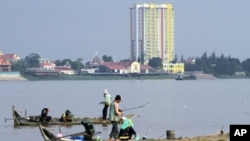Although the dispute about conflicting claims in the South China Sea took center stage at the recent ASEAN security forum, U.S. officials also focused on addressing another potential conflict relating to Asia's growing energy needs. The Mekong River and its tributaries sustain tens of millions of people in Southeast Asia, but the river is also the site of several controversial new hydropower projects.
U.S. Secretary of State Hillary Clinton came to the recent security forum of the Association of Southeast Asian Nations in Bali to say the United States intends to remain engaged in the political and economic development of the region. As part of that effort, she talked about how Washington is fostering responsible development through a $221 million U.S. assistance program in the Lower Mekong River Basin.
The money will used to fund education, environment, health and infrastructure programs in underdeveloped areas in Cambodia, Laos, Thailand, and Vietnam.
The U.S. Ambassador to ASEAN David Carden says the United States is concerned about the impact of several large hydropower projects that some environmental groups have warned could seriously affect key waterways in the region.
"The dams that are being proposed and some that have already been built have not at this juncture been fully vetted as to what their scientific impact is. And it is not only this region but indeed in the interest of the world for food security purposes, for environmental purposes, for peace and security purpose, for the development of the Lower Mekong to happen intelligently and consistent with the best science that can be brought to bear on it."
More than 60 million people live in the Lower Mekong Basin, an area of more than 600,000 square kilometers. It is the world's largest inland fishery. Rice farmers also depend on water and sediment from the river to irrigate and fertilize their crops.
But there is growing concern that the construction of hydroelectric dams in China and plans for more dams in Laos and Cambodia could cause significant environmental and economic damage in lower Mekong countries like Vietnam.
Ambassador Carden says the U.S. assistance is broadly aimed at providing aid to help maintain peace and security in a region where there is a potential for cross border conflict.
"I think that the simple truth is, whatever any motivations anybody wants to attribute to these efforts, I think it is clearly the case that the world, not just the region, the world recognizes the need for all of us to work together to address these border-less problems."
But Milton Osborne, Southeast Asia analyst with Australia's Lowy Institute for International Policy says the U.S. engagement in Asia is motivated in large part by concern about China's growing influence.
"The continuing rise of China in economic terms is clearly a concern for the United States and this is one, the Mekong initiative is one of several ways the United States is making clear that it is continuing to have a broad interest in this part of the world."
Osborne says the aid money does not give U.S. officials access to negotiate in any Mekong delta development negotiations, but it shows the United States is committed to play a constructive role in Asia's future.
U.S. Assistance to Mekong Region Aimed at Preventing Cross Border Conflict
- Brian Padden
- VOA




